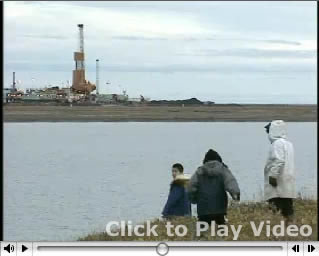|
Our Communities

One sixth of all the people of Alaska are indigenous. Of these, more than half are Eskimo. One third are Athabaskan-speaking Indians who combine hunting, fishing and trapping with work for cash.
The Arctic National Wildlife Refuge is almost as large as Austria, yet its only settlement is the Inupiat Eskimo village of Kaktovik on the northwest corner of the Refuge. Almost 250 people live there, subsisting on fishing, hunting, and whaling.

Healthy communities require vigilance and creativity. Check out the Community section of the Grassroots Action Toolkit for Commnities@Risk and up-to-date information, links and tools that can help.
|
Formerly nomadic, the Gwich'in Indians live in fifteen villages in Canada and northeastern Alaska that are located along the migration route of the Porcupine herd of caribou. The Gwich'in are greatly concerned about the integrity of the caribou calving grounds on the north slope of the wildlife refuge. For them the coastal plain where caribou calve is sacred ground. They call it "the place where life begins."
They depend on the caribou for their subsistence and for the survival of their culture. "We are caribou people," says Sarah James, an Alaskan Gwich'in leader and a recipient of the 2002 Goldman Prize for the Environment. Unlike other Alaska Natives, who, under the Alaska Native Claims Settlement Act of 1971, receive revenue from oil and other resources through Native Corporations, the Gwich'in have chosen to maintain their traditional way of life and to exercise their hunting, fishing and gathering rights. They know that money is no substitute for a herd of caribou. No job can replace their culture that depends upon every aspect of their relationship with caribou, from the hunt to the feast to the making of clothing, tools, and other objects from the animal's remains--skin, hooves, intestines, and all. In 1988, the Gwich'in Indians from Alaska and Canada declared their support for prohibiting development in the caribou calving grounds with the intention of making the entire Refuge a designated National Wilderness area.
Like the Gwich'in, the Inupiat Eskimo also remain deeply connected to the land and sea around them. While some residents of Kaktovik have jobs, their way of life revolves around catching pike and salmon, hunting for moose, polar bear, and seals, and whaling; they are permitted three bowhead whales each year. Long-time Alaska resident Debbie Miller describes a house in Kaktovik: "caribou hides draped over porch railings, sealskins stretched and tacked on walls, creative designs etched on whale baleen, jars of frozen bearded seal oil tucked beneath a stairwell. The Inupiat will continue to hunt and fish, as sure as they will breathe." |

